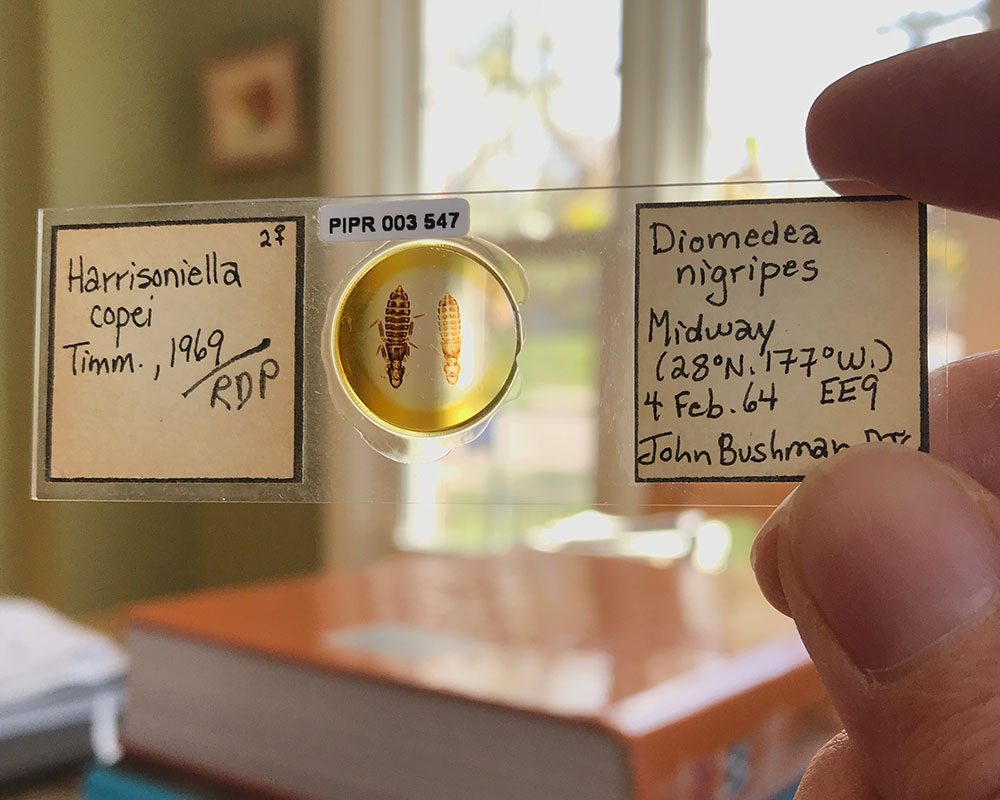If you’re watching wildlife from your kitchen window, you are witnessing several levels of biodiversity that cannot be seen through binoculars. Birds and mammals are hosts to many parasites that live amongst their fur and feathers—lice, fleas, flies, ticks and mites. Some can transmit pathogens that affect humans, such as ticks that carry Lyme disease or prairie dog fleas that house the literal plague. Yet scientist are just scratching the surface of the world of parasites. Millions of specimens are sitting in museums all over the world, but a lack of digital records make them hard to find and study.

PHOTO CREDIT: Sarah Bush
An albatross with its particular species of lice shown.
Download Full-Res ImageTo fill this void, 22 museums and institutions in North America have teamed up to digitize data for over 1.2 million parasite specimens in the next three years, including Sarah Bush, associate professor in the School of Biological Sciences. Beginning on April 16, they are participating in a global transcription event called “We Dig Bio,” where citizen scientists will transcribe as much as possible in 48 hours.
“Parasites are understudied—they’re not cute. But they have a huge impact on the health and distribution of their hosts,” said Bush. “If we have this data digitized, a biologist from across the world can start understanding where species are found, and what they interact with. We are still in the discovery phase. There are new species in your backyard that we don’t know about.”
To digitize specimens, Bush and colleagues have turned to a citizen science platform called Notes from Nature, where anyone, anywhere can go online and help transcribe data from historic microscope slides. Bush and biologist Dale Clayton, professor at the U, have a collection of microscope slides with more than 80,000 parasites from extinct birds, new species and new genera, all waiting to be discovered.
“Our goal is to better understand the distribution and evolution of parasite diversity,” explained Bush. “By digitizing data from existing specimens, we are hoping to understand where these parasites occur? What hosts these parasites infest? Which parasites are most likely to vector pathogens to humans, and whether their distribution has changed over time?”

PHOTO CREDIT: Sarah Bush
Sarah Bush holds a microscope slide containing a male and female pair of lice. The labels have the species, genus, host, collector, and date and location collected.
Download Full-Res ImageCitizen scientists involved in this project get to peek through the parasite collection that likely holds species that have never been found before. Recently, Bush’s research group described new species of lice on house finches and black-headed grosbeaks in the Journal of Parasitology.
“People have been watching these common birds at their feeders for ages, but most people don’t know that species unknown to science are also visiting bird feeders. We only discovered the species of lice on these birds about two years ago,” said Bush. “You never know what you’re going to find. The slides you see may be parasites found in your backyard, or they might be a parasite collected 100+ years ago in the far reaches of New Guinea.”
If you are interested in helping with this citizen science project visit the “Terrestrial Parasite Tracker” project on the Notes from Nature website.
